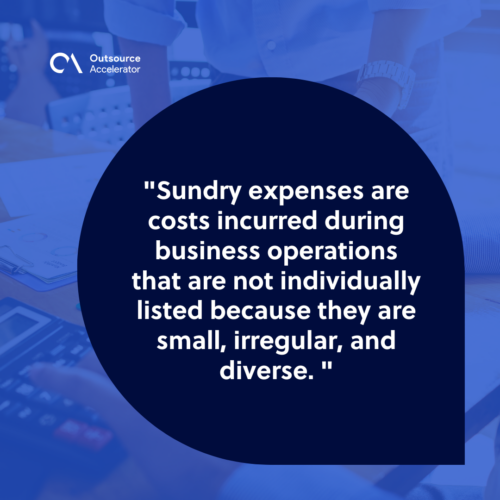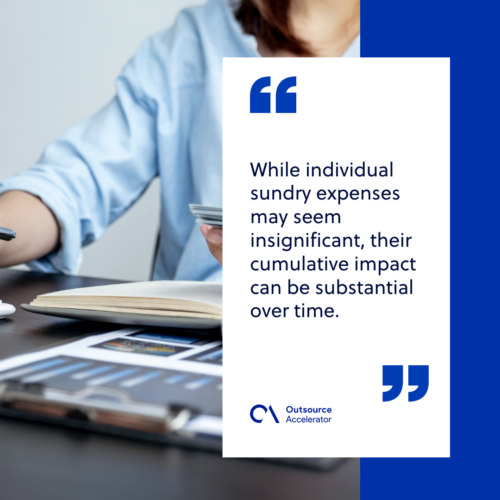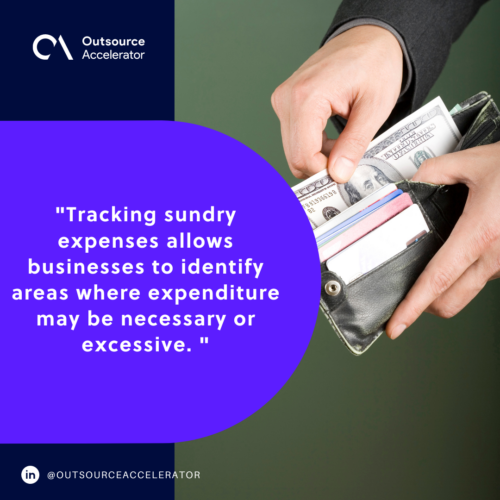What are sundry expenses?

Sundry expenses often lurk in the shadows, overlooked and underestimated. But these often neglected costs can add up to significant amounts over time.
Understanding and effectively managing sundry expenses can make a notable difference in one’s budget and financial success.
In this article, we’ll enter the world of sundry expenses, exploring their nature and importance and how to gain better control over them for your own financial stability.
Sundry expenses defined
Sundry expenses are costs incurred during business operations that are not individually listed because they are small, irregular, and diverse. The term “sundry” can also mean miscellaneous, which is what these costs are also referred to as.
Sundry expenses cannot be easily classified under specific day-to-day expense categories. They’re often considered irregular, random, or non-routine expenses that vary in denomination.

Sundry expenses can include things like:
- Minor office supplies
- Small repairs
- Petty cash transactions
- Entertainment expenses
- Other incidental expenditures
Sundry expenses vs. General expenses
Sundry expenses and general expenses are both components of overall expenditure but differ in some key aspects:
| Sundry expenses | General expenses | |
| Nature | Random expenses that do not fit into standard expense categories | Regular, recurring expenses that are necessary for day-to-day business operations |
| Frequency | Occur sporadically and may rise unexpectedly as one-off or occasional expenses | Regularly incurring expenses |
| Scope and specificity | Encompass a broad range of miscellaneous costs; lack a clear and distinct classification | Specific and well-defined; can be categorized under certain budgetary headings |
| Impact | Have a cumulative effect over time | Have a more substantial impact on overall financial stability |
| Management | Requires careful monitoring of various small transactions | Part of a well-defined budget, making it easier to plan and control spending |
Characteristics of sundry expenses
Sundry expenses typically display these distinct characteristics:
Small and irregular amounts
Sundry expenses are typically small in individual value and irregular in frequency. They may include minor transactions or purchases that occur infrequently but can collectively impact financial health over time.
Miscellaneous nature
Sundry expenses encompass a wide range of costs that don’t fit into specific expense categories. This is why many organizations have the term represent a catch-all category for various incidental expenditures.
Difficult classification
These costs pose a challenge when it comes to their classification in accounting systems.
Businesses may find it hard to allocate these costs to specific budgetary categories, requiring a more flexible approach to financial management.
Accumulative impact
While individual sundry expenses may seem insignificant, their cumulative impact can be substantial over time. Businesses must be watchful that these seemingly small costs don’t majorly affect overall financial stability.

Challenge in budgeting
Sundry expenses are challenging to budget as they are not easily anticipated or accounted for in advance. Organizations must adopt strategies to accommodate and manage these unforeseen costs.
Requires vigilant monitoring
Managing sundry expenses necessitates vigilant monitoring of day-to-day transactions to identify and track miscellaneous costs. This proactive approach is crucial to prevent these expenses from accumulating unnoticed.
Note that the characteristics of sundry expenses may vary between industries and companies. Their specific definitions can depend on industry practices and individual company policies.
Why track sundry expenses
Tracking sundry expenses is important for these main reasons:
Financial record-keeping
Recording and tracking sundry expenses allows for accurate financial record-keeping. Even though these expenses may be irregular and of relatively low value, they should still be recorded on financial statements.
Maintaining a complete record of sundry expenses ensures that all items are properly accounted for and can be referred to when needed.
This also promotes financial awareness within the organization as it reveals where money is being spent.
Tax and compliance purposes
Sundry expenses, despite their small size, can impact the taxable nature of a business. By recording these costs, businesses can identify and claim eligible deductions or credits when filing taxes.
It also ensures compliance with accounting and auditing regulations. This documentation is useful when providing transparency and supporting the accuracy and integrity of financial statements.
Cost control
Tracking sundry expenses allows businesses to identify areas where expenditure may be necessary or excessive.
This insight is valuable for recognizing trends, making adjustments to unrestricted spending, and implementing strategies to optimize financial resources.

Budgeting and forecasting accuracy
Incorporating sundry expenses into budgeting and forecasting processes improves accuracy in financial planning. By tracking these expenses, businesses can better anticipate and allocate financial resources, leading to more realistic budgets and forecasts.
How to record sundry expenses
Recording sundry expenses involves a systematic approach to ensure accurate and organized documentation of miscellaneous and diverse costs.
Here’s a step-by-step guide on how to record sundry expenses:
- Identify sundry expenses. Businesses should first identify and categorize sundry expenses as best as they can.
- Establish a sundry expenses account. A general ledger account can be created to record sundry expenses under one heading.
- Maintain records. Maintain records of the date, description, and amount of each expense. Assign responsible parties to ensure accountability and accurate tracking.
- Reconcile accounts. This process identifies any discrepancies, errors, or omissions.
- Integrate with budgeting. Integration ensures that sundry expenses are considered when crafting financial plans. You may want to implement a review and approval process to guarantee alignment.
- Organize documentation. Keep all supporting documentation, such as receipts and invoices, organized and easily accessible.
- Communicate and train. Communicate the importance of accurate sundry expense recording to relevant stakeholders and provide training if necessary.
By following these general guidelines, you can ensure a structured and reliable system for recording sundry expenses.
Keeping track of all your expenses aids in financial transparency and facilitates effective budget management and decision-making.







 Independent
Independent




